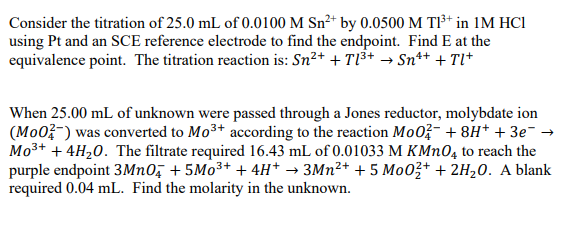Consider the titration of 25.0 mL of 0.0100 M Sn²+ by 0.0500 M TI³* in 1M HCl using Pt and an SCE reference electrode to find the endpoint. Find E at the equivalence point. The titration reaction is: Sn²+ + Tl³+ → Sn*+ + Tl* When 25.00 mL of unknown were passed through a Jones reductor, molybdate ion (Mo0?-) was converted to Mo3+ according to the reaction Mo0?- + 8H* + 3e¯ → Mo3+ + 4H20. The filtrate required 16.43 mL of 0.01033 M KMN0, to reach the purple endpoint 3MN0, + 5M03+ + 4H* → 3MN²+ + 5 Mo03+ + 2H,0. A blank required 0.04 mL. Find the molarity in the unknown.
Consider the titration of 25.0 mL of 0.0100 M Sn²+ by 0.0500 M TI³* in 1M HCl using Pt and an SCE reference electrode to find the endpoint. Find E at the equivalence point. The titration reaction is: Sn²+ + Tl³+ → Sn*+ + Tl* When 25.00 mL of unknown were passed through a Jones reductor, molybdate ion (Mo0?-) was converted to Mo3+ according to the reaction Mo0?- + 8H* + 3e¯ → Mo3+ + 4H20. The filtrate required 16.43 mL of 0.01033 M KMN0, to reach the purple endpoint 3MN0, + 5M03+ + 4H* → 3MN²+ + 5 Mo03+ + 2H,0. A blank required 0.04 mL. Find the molarity in the unknown.
Principles of Instrumental Analysis
7th Edition
ISBN:9781305577213
Author:Douglas A. Skoog, F. James Holler, Stanley R. Crouch
Publisher:Douglas A. Skoog, F. James Holler, Stanley R. Crouch
ChapterA1: Evaluation Of Analytical Data
Section: Chapter Questions
Problem A1.23QAP
Related questions
Question

Transcribed Image Text:Consider the titration of 25.0 mL of 0.0100 M Sn²+ by 0.0500 M TI³* in 1M HCl
using Pt and an SCE reference electrode to find the endpoint. Find E at the
equivalence point. The titration reaction is: Sn²+ + Tl³+ → Sn*+ + Tl*
When 25.00 mL of unknown were passed through a Jones reductor, molybdate ion
(Mo0?-) was converted to Mo3+ according to the reaction Mo0?- + 8H* + 3e¯ →
Mo3+ + 4H20. The filtrate required 16.43 mL of 0.01033 M KMN0, to reach the
purple endpoint 3MN0, + 5M03+ + 4H* → 3MN²+ + 5 Mo03+ + 2H,0. A blank
required 0.04 mL. Find the molarity in the unknown.
Expert Solution
This question has been solved!
Explore an expertly crafted, step-by-step solution for a thorough understanding of key concepts.
This is a popular solution!
Trending now
This is a popular solution!
Step by step
Solved in 2 steps with 1 images

Knowledge Booster
Learn more about
Need a deep-dive on the concept behind this application? Look no further. Learn more about this topic, chemistry and related others by exploring similar questions and additional content below.Recommended textbooks for you

Principles of Instrumental Analysis
Chemistry
ISBN:
9781305577213
Author:
Douglas A. Skoog, F. James Holler, Stanley R. Crouch
Publisher:
Cengage Learning

Principles of Instrumental Analysis
Chemistry
ISBN:
9781305577213
Author:
Douglas A. Skoog, F. James Holler, Stanley R. Crouch
Publisher:
Cengage Learning